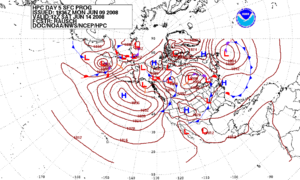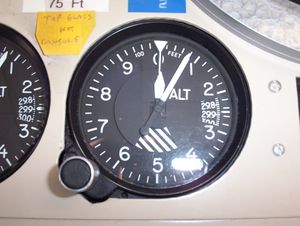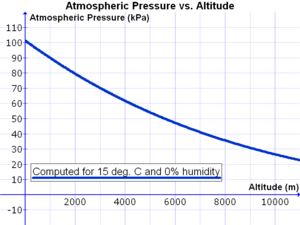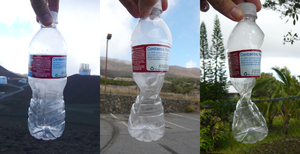ضغط جوي
الضغط الجوي Atmospheric pressure هو وزن عمود من الهواء مساحة مقطعه وحدة المساحات بارتفاع يعادل سمك الغلاف الجوي. الضغط الجوي = 1 atm أو بالتقريب 1 بار. وهو يتكوّن من عدة غازات (النيتروجين 78% و الأكسجين 21%، بالإضافة إلى غازات أُخرى). يتناقص الضغط الجوي مع الإرتفاع عن مستوى سطح البحر، ويبلغ عند مستوى سطح البحر 1 atm أو 1.0132 بار.
المناطق ذات الضغط الجوي المنخفض لها كتلة غلاف جوي أقل، بينما المناطق ذات الضغط الجوي المرتفع لها كتلة غلاف جوي أكثر من غيرها.
يتكون الضغط الجوي المنخفض عندما ترتفع درجة الحرارة إذ يؤدي هذا إلى تسارع جزيئات الهواء وابتعادها عن بعضها، ويتكون الضغط الجوي المرتفع عندما تنخفض درجة الحرارة، إذ يؤدي ذلك إلى بطء جزيئات الهواء واقترابها من بعضها.
يبلغ وزن عمود الهواء، عند سطح البحر، مساحة مقطعه متر مربّع، وارتفاع سُمك الغلاف الجوي، 10 طن تقريباً. كلما زاد الارتفاع عن سطح البحر قلَّ الضغط الجوي، والعكس صحيح.
. . . . . . . . . . . . . . . . . . . . . . . . . . . . . . . . . . . . . . . . . . . . . . . . . . . . . . . . . . . . . . . . . . . . . . . . . . . . . . . . . . . . . . . . . . . . . . . . . . . . . . . . . . . . . . . . . . . . . . . . . . . . . . . . . . . . . . . . . . . . . . . . . . . . . . . . . . . . . . . . . . . . . . . .
الضغط الجوي القياسي
يبلغ الضغط الجوي 760 ميلليمتر زئبق = 325 101 باسكال = 1.013 بار
- أي أن وزن عمود من الزئبق مساحة مقطعه 1 سنتيمتر مربع وارتفاعه 760 ملليمتر. وهذا يعادل وزن عمود الهواء الواقع على 1 سنتيمتر مربع وارتفاعه ارتفاع الغلاف الجوي للأرض.
- فإذا كانت كثافة الزئبق 13.53 جرام/ سنتيمتر مكعب، فيمكن حساب الضغط الجوي من خلال القانون الآتي:
وهذا يعني أن:
الضغط الجوي = كثافة الزئبق × إرتفاع عمود الزئبق × عجلة الجاذبية الأرضية.
الضغط الجوي = 13.53 × 1000 ×0.76 × 9.81 = 100874.268 نيوتن / متر مربع[1]
وإذا أردنا حساب وزن عمود الهواء من الغلاف الجوي الواقع على 1 متر مربع بالكيلوجرام، نقوم بقسمة الناتج المذكور أعلاه على قيمة عجلة الجاذبية الأرضية نحصل على:
وزن عمود الهواء بالكيلوجرام على المتر المربع = 100874.268 ÷ 9.81 = 10282.8 كيلوجرام/ متر مربع.
أي أكثر من 10 طن على المتر المربع.
متوسط الضغط الجوي عند سطح البحر
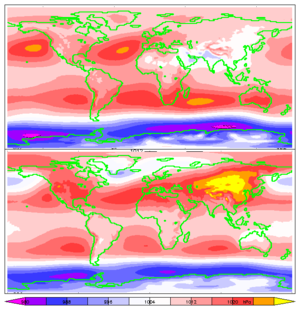
يقاس بالبارومتر ويتم قياسه على مستوى سطح البحر، وهو ما يتم بالعادة ذكره في نشرات الطقس على الإذاعة والتلفزيون والصحف والانترنت.
ويستعمل علم المناخ الضغط عند سطح البحر من أجل تحديد وتصنيف مراكز الضغط الجوي على الكرة الأرضية. فنجده يعرف مجموعة من مراكز الضغط الجوي التي تهيمن على مناخ وطقس مناطق واسعة من الكرة الأرضية. وهي مصنفة إلى نوعين: المرتفعات الجوية والمنخفضات الجوية. فمن بين هذه المرتفعات بالنصف الشمالي من الكرة الأرضية، نجد مرتفع الآصور ومرتفع سيبيريا. ومن أهم المنخفضات الجوية للنصف الشمالي للكرة الأرضية نذكر منخفض آيسلندا.
altimeter setting in aviation is an atmospheric pressure adjustment.
Average sea-level pressure is 1,013.25 hPa (29.921 inHg; 760.00 mmHg). In aviation weather reports (METAR), QNH is transmitted around the world in hectopascals or millibars (1 hectopascal = 1 millibar), except in the United States, Canada, and Japan where it is reported in inches of mercury (to two decimal places). The United States and Canada also report sea-level pressure SLP, which is adjusted to sea level by a different method, in the remarks section, not in the internationally transmitted part of the code, in hectopascals or millibars.[2] However, in Canada's public weather reports, sea level pressure is instead reported in kilopascals.[3]
In the US weather code remarks, three digits are all that are transmitted; decimal points and the one or two most significant digits are omitted: 1,013.2 hPa (14.695 psi) is transmitted as 132; 1,000 hPa (100 kPa) is transmitted as 000; 998.7 hPa is transmitted as 987; etc. The highest sea-level pressure on Earth occurs in Siberia, where the Siberian High often attains a sea-level pressure above 1,050 hPa (15.2 psi; 31 inHg), with record highs close to 1,085 hPa (15.74 psi; 32.0 inHg). The lowest measurable sea-level pressure is found at the centres of tropical cyclones and tornadoes, with a record low of 870 hPa (12.6 psi; 26 inHg).
اختلاف الضغط الجوي باختلاف الارتفاع
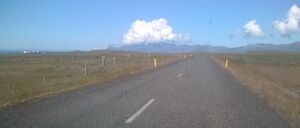
يختلف الضغط الجوي عند سطح الأرض ارتفاعاً إلى طبقة الميزوسفير. على الرغم من تغير الضغط الجوي بتغير حالة الطقس، قامت ناسا بوضع متوسط حسابي لجميع الحالات ولجميع المناطق على مرور السنين. ويمكن ايجاد الضغط الجوي من خلال معادلة تصف علاقة الارتفاع بالضغط الجوي، كلما زاد الارتفاع عن سطح الأرض قل الضغط الجوي [4] مع الأخذ بالاعتبار تأثير الحرارة والرطوبة على دقة النتيجة. على ارتفاع منخفض عن سطح البحر، ينخفض الضغط الجوي بمقدار cca 1.2 kPa لكل 100 متر
للأرتفاعات ضمن طبقة التروبوسفير نستطيع ايجاد قمية الضغط الجوي p بالنسبة للأرتفاع h من خلال معادلة الصيغة البارومترية
At low altitudes above sea level, the pressure decreases by about 1.2 kPa (12 hPa) for every 100 metres. For higher altitudes within the troposphere, the following equation (the barometric formula) relates atmospheric pressure p to altitude h:
The values in these equations are:
| Parameter | الوصف | القيمة |
|---|---|---|
| h | Height above mean sea level | m |
| p0 | Sea level standard atmospheric pressure | 101,325 Pa |
| L | Temperature lapse rate, = g/cp for dry air | ~ 0.00976 K/m |
| cp | Constant-pressure specific heat | 1,004.68506 J/(kg·K) |
| T0 | Sea level standard temperature | 288.16 K |
| g | Earth-surface gravitational acceleration | 9.80665 m/s2 |
| M | Molar mass of dry air | 0.02896968 kg/mol |
| R0 | Universal gas constant | 8.314462618 J/(mol·K) |
وحدات الضغط
پاسكال (Pa) |
bar (bar) |
ضغط جوي تقني (at) |
atmosphere (atm) |
torr (Torr) |
رطل-قوة لكل بوصة مربعة (psi) | |
|---|---|---|---|---|---|---|
| 1 Pa | ≡ 1 N/m2 | 10−5 | 1.0197×10−5 | 9.8692×10−6 | 7.5006×10−3 | 145.04×10−6 |
| 1 bar | 100,000 | ≡ 106 داين/cm2 | 1.0197 | 0.98692 | 750.06 | 14.5037744 |
| 1 at | 98,066.5 | 0.980665 | ≡ 1 kgf/cm2 | 0.96784 | 735.56 | 14.223 |
| 1 atm | 101,325 | 1.01325 | 1.0332 | ≡ 1 atm | 760 | 14.696 |
| 1 torr | 133.322 | 1.3332×10−3 | 1.3595×10−3 | 1.3158×10−3 | ≡ 1 Torr; ≈ 1 mmHg | 19.337×10−3 |
| 1 psi | 6,894.76 | 68.948×10−3 | 70.307×10−3 | 68.046×10−3 | 51.715 | ≡ 1 lbf/in2 |
Example reading: 1 Pa = 1 N/m2 = 10−5 bar = 10.197×10−6 at = 9.8692×10−6 atm, etc.
. . . . . . . . . . . . . . . . . . . . . . . . . . . . . . . . . . . . . . . . . . . . . . . . . . . . . . . . . . . . . . . . . . . . . . . . . . . . . . . . . . . . . . . . . . . . . . . . . . . . . . . . . . . . . . . . . . . . . . . . . . . . . . . . . . . . . . . . . . . . . . . . . . . . . . . . . . . . . . . . . . . . . . . .
التفاوت المحلي
Atmospheric pressure varies widely on Earth, and these changes are important in studying weather and climate. Atmospheric pressure shows a diurnal or semidiurnal (twice-daily) cycle caused by global atmospheric tides. This effect is strongest in tropical zones, with an amplitude of a few hectopascals, and almost zero in polar areas. These variations have two superimposed cycles, a circadian (24 h) cycle, and a semi-circadian (12 h) cycle.
سجلات
The highest adjusted-to-sea level barometric pressure ever recorded on Earth (above 750 meters) was 1,084.8 hPa (32.03 inHg) measured in Tosontsengel, Mongolia on 19 December 2001.[5] The highest adjusted-to-sea level barometric pressure ever recorded (below 750 meters) was at Agata in Evenk Autonomous Okrug, Russia (66°53' N, 93°28' E, elevation: 261 m, 856 ft) on 31 December 1968 of 1,083.8 hPa (32.005 inHg).[6] The discrimination is due to the problematic assumptions (assuming a standard lapse rate) associated with reduction of sea level from high elevations.[5]
The Dead Sea, the lowest place on Earth at 430 metres (1,410 ft) below sea level, has a correspondingly high typical atmospheric pressure of 1,065 hPa.[7] A below-sea-level surface pressure record of 1,081.8 hPa (31.95 inHg) was set on 21 February 1961.[8]
The lowest non-tornadic atmospheric pressure ever measured was 870 hPa (0.858 atm; 25.69 inHg), set on 12 October 1979, during Typhoon Tip in the western Pacific Ocean. The measurement was based on an instrumental observation made from a reconnaissance aircraft.[9]
القياس على أساس عمق الماء
One atmosphere (101.325 kPa or 14.7 psi) is also the pressure caused by the weight of a column of freshwater of approximately 10.3 m (33.8 ft). Thus, a diver 10.3 m underwater experiences a pressure of about 2 atmospheres (1 atm of air plus 1 atm of water). Conversely, 10.3 m is the maximum height to which water can be raised using suction under standard atmospheric conditions.
Low pressures, such as natural gas lines, are sometimes specified in inches of water, typically written as w.c. (water column) gauge or w.g. (inches water) gauge. A typical gas-using residential appliance in the US is rated for a maximum of 1⁄2 psi (3.4 kPa; 34 mbar), which is approximately 14 w.g. Similar metric units with a wide variety of names and notation based on millimetres, centimetres or metres are now less commonly used.
تأثير الارتفاع على الإنسان
يقل الضغط الجوي بالارتفاع عن سطح الأرض وبالتالي يقل الأكسجين في الجو مما يكون له تأثير على الكائنات الحية التي تتنفس الهواء، وتحتاج الأكسجين في تنفسها. وتأثير الارتفاع على الإنسان يجري كالآتي:
- ارتفاع 2400 متر: هذا يعادل الضغط داخل طائرات الركاب، ولا يكون له تأثير
- ارتفاع 2500 متر: يبدأ بعض الناس الحساسون بالشعور بالدوار.
- ارتفاع 3500 متر: يشعر نحو ثلث الناس الغير معتادين على ذلك بالشعور بالدوخان والتعب.
- ارتفاع 4000 متر: يشعر 95% من غير المعتادين بالدوخان والتعب.
- ارتفاع 5500 متر: يستطيع بعض الناس العيش على هذا الارتفاع. وتبلغ كمية الأكسجين على هذا الارتفاع نحو نصف كميته عند سطح البحر.
- ارتفاع 7500 متر: هنا تبدأ المنطقة القاتلة: متسلقي الجبال لا يستطيعون البقاء على ذلك العلو أكثر من يوم بدون أنابيب الأكسجين.
- ارتفاع 8848 متر: أعلى نقطة على سطح الأرض، وهى قمة جبل إفرست. لا تستطيع البقاء على ذلك العلو من دون أنابيب الأكسجين
- ارتفاع 12192 متر: متوسط ارتفاع مستوى الطيران للطائرات التجارية. وهنا يتم إمداد كابينة الطائرة بالهواء المضغوط من الخارج مع ضبط درجة حرارته.
تغير الضغط الجوي بالارتفاع
ينخفض الضغط الجوي كلما زاد الارتفاع عن سطح البحر طبقا ل دالة أسية. وعلى الرغم من تغير الجو أيضا بسبب أحوال الطقس والحرارة فقد قامت ناسا بحساب تغير متوسط الضغط على ارتفاعات مختلف لجميع المناطق الأرض. وتعطينا القائمة التالية تغير الضغط الجوي بالارتفاع بالتقريب:
| جزء من 1 atm | متوسط الارتفاع | |
|---|---|---|
| (متر) | (قدم) | |
| 1 | 0 | 0 |
| 1/2 | 5،486 | 18،000 |
| 1/3 | 8،376 | 27،480 |
| 1/10 | 16،132 | 52،926 |
| 1/100 | 30،901 | 101،381 |
| 1/1000 | 48،467 | 159،013 |
| 1/10000 | 69،464 | 227،899 |
| 1/100000 | 86،282 | 283،076 |
سطح ضغطي
السطح الضغطي هو سطح له قيمة ضغط جوي متوسطة واحدة في كافة امتداداته، كما في السطح الضغطي 1000 مليبار، 850 مليبار، 700 مليبار، 500 مليبار، 300 مليبار، 200 مليبار، 100 مليبار، ويتصف السطح الضغطي في كونه لا يمتد بشكل أفقي تماماً، بل نجده كائلاً وأحياناً متموجاً، وذلك لأن معدل تناقص الضغط مع الارتفاع ليس ثابتاً، لأنه يتوقف على درجة الحرارة والرياح وكثافة الهواء.
نقطة غليان الماء
طبقا للتعريف يغلى الماء عند درجة حرارة 100 مئوية. ودرجة الغليان هي درجة الحرارة التي يتساوى عندها ضغط البخار مع الضغط المحيط بالماء.[10]. وبسبب ذلك تنخفض درجة غليان الماء تحت وطأة الضغط المنخفض وتعلو مع علو الضغط. ولهذا يحتاج الطبخ على الأعالى أعلى من مستوى سطح البحر لأوقات تزيد عن المعهود.[11]
ويمكن تحديد ذلك عن طريق معرفة نقطة غليان الماء على ذلك الارتفاع. وقد استخدمت تلك الطريقة خلال القرن التاسع عشر عن طريق الرحالة والمستكشفين لتحديد ارتفاع المناطق التي كانوا يزورونها.[13]
. . . . . . . . . . . . . . . . . . . . . . . . . . . . . . . . . . . . . . . . . . . . . . . . . . . . . . . . . . . . . . . . . . . . . . . . . . . . . . . . . . . . . . . . . . . . . . . . . . . . . . . . . . . . . . . . . . . . . . . . . . . . . . . . . . . . . . . . . . . . . . . . . . . . . . . . . . . . . . . . . . . . . . . .
القياس والخرائط
An important application of the knowledge that atmospheric pressure varies directly with altitude was in determining the height of hills and mountains, thanks to reliable pressure measurement devices. In 1774, Maskelyne was confirming Newton's theory of gravitation at and on Schiehallion mountain in Scotland, and he needed to measure elevations on the mountain's sides accurately. William Roy, using barometric pressure, was able to confirm Maskelyne's height determinations, the agreement being to be within one meter (3.28 feet). This method became and continues to be useful for survey work and map making.[14]
انظر أيضا
- Atmospheric density
- Atmosphere of Earth
- Barometric formula
- Barotrauma – physical damage to body tissues caused by a difference in pressure between an air space inside or beside the body and the surrounding gas or liquid.
- Cabin pressurization
- Cavitation
- Collapsing can – an aluminium can is crushed by the atmospheric pressure surrounding it
- Effects of high altitude on humans
- High-pressure area
- International Standard Atmosphere, a tabulation of typical variations of principal thermodynamic variables of the atmosphere (pressure, density, temperature, etc.) with altitude, at middle latitudes.
- Low-pressure area
- Meteorology
- NRLMSISE-00, an empirical, global reference atmospheric model of the Earth from ground to space
- Plenum chamber
- Pressure
- Pressure measurement
- Standard atmosphere (unit)
- Horse latitudes
المراجع
- ^ علم المائع Archived 6 سبتمبر 2017 at the Wayback Machine
- ^ Sample METAR of CYVR Archived 2019-05-25 at the Wayback Machine Nav Canada
- ^ Montreal Current Weather, CBC Montreal, Canada, http://www.cbc.ca/montreal/weather/s0000635.html, retrieved on 2014-03-30
- ^ A quick derivation relating altitude to air pressure. by Portland State Aerospace Society, 2004, accessed 05-03-2011.[وصلة مكسورة], original article cached at "Webarchive": Archived 19 فبراير 2015 at the Wayback Machine
- ^ أ ب World: Highest Sea Level Air Pressure Above 750 m, World Meteorological Organization's World Weather & Climate Extremes Archive, 2001-12-19, http://wmo.asu.edu/highest-sea-lvl-air-pressure-above-700m, retrieved on 2013-04-15
- ^ World: Highest Sea Level Air Pressure Below 750 m, World Meteorological Organization's World Weather & Climate Extremes Archive, 1968-12-31, http://wmo.asu.edu/world-highest-sea-level-air-pressure-below-700m, retrieved on 2013-04-15
- ^ Kramer, MR; Springer C; Berkman N; Glazer M; Bublil M; Bar-Yishay E; Godfrey S (March 1998). "Rehabilitation of hypoxemic patients with COPD at low altitude at the Dead Sea, the lowest place on earth" (PDF). Chest. 113 (3): 571–575. doi:10.1378/chest.113.3.571. PMID 9515826. Archived from the original (PDF) on 2013-10-29.
- ^ Court, Arnold (1969). "Improbable Pressure Extreme: 1070 Mb". Bulletin of the American Meteorological Society. 50 (4): 248–50. JSTOR 26252600.
- ^ Chris Landsea (2010-04-21). "Subject: E1), Which is the most intense tropical cyclone on record?". Atlantic Oceanographic and Meteorological Laboratory. Archived from the original on 6 December 2010. Retrieved 2010-11-23.
- ^ Vapor Pressure, original article cached at "Webarchive": Archived 14 سبتمبر 2017 at the Wayback Machine
- ^ Crisco - Articles & Tips - Cooking Tips - High Altitude Cooking[وصلة مكسورة], original article cached at "Webarchive": Archived 23 سبتمبر 2010 at the Wayback Machine
- ^
{{cite web}}: Empty citation (help) - ^ [M.N. Berberan-Santos, E.N. Bodunov, L. Pogliani, On the barometric formula. Am. J. Phys. 65 (5), 404-412 (1997)]
- ^ Hewitt, Rachel, Map of a Nation – a Biography of the Ordnance Survey ISBN 1-84708-098-7
- مقالات ذات وصلات خارجية مكسورة from يوليو 2017
- CS1 errors: empty citation
- Short description is different from Wikidata
- Missing redirects
- Articles with hatnote templates targeting a nonexistent page
- غلاف جوي
- ديناميكا حرارية جوية
- ضغط
- طب غوص وعلم وظائف الأعضاء للغوص وفيزياء الغوص
- علوم الأرض
- ثرموديناميكا الغلاف الجوي
- فيزياء الغوص
- وحدات ضغط


